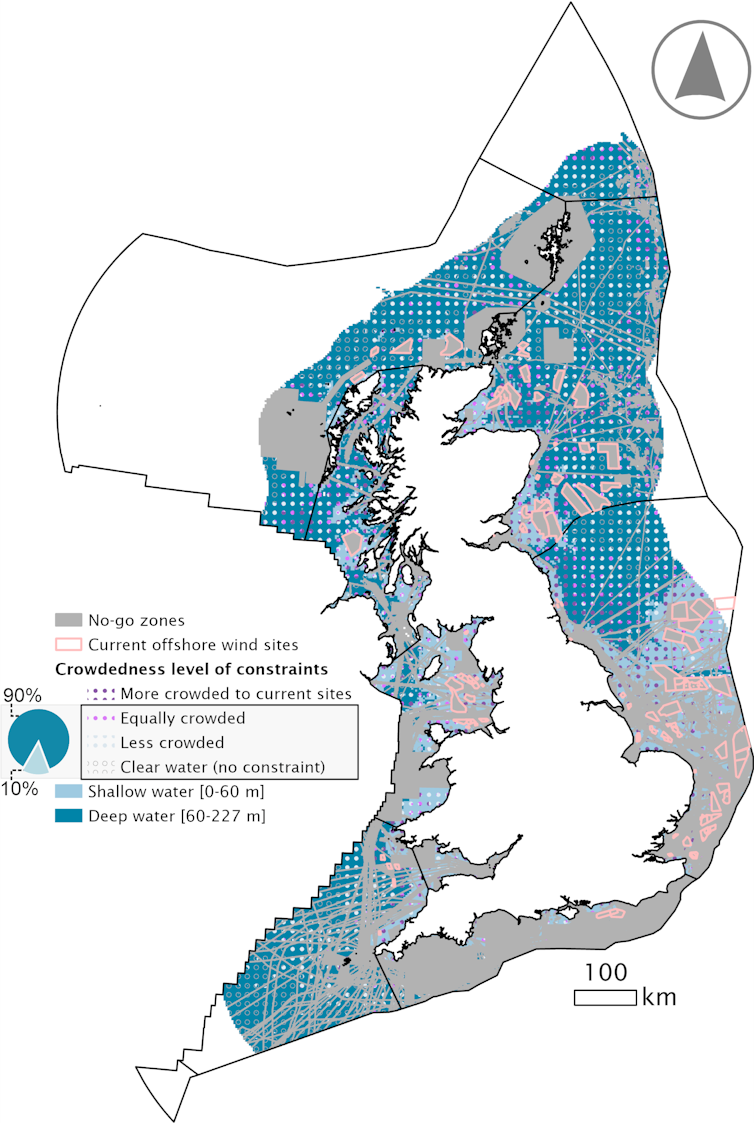To reach net zero, the world may need as many 200,000 offshore wind turbines generating 2,000 gigawatts (GW) of energy.
To put this in context, by the end of 2022, 63 GW of offshore wind capacity had been installed worldwide. Within the next 28 years, the offshore wind energy sector needs to expand so that it is capable of producing 32 times its current energy capacity.
But where do we put all these extra offshore wind farms? Their locations will need to be chosen in order to maximise their energy output and their social benefits, while ensuring they have the minimum impact possible on the environment. Balancing all these factors is not a straightforward task.
How much space do we need?
To work out where to place new turbines, a good starting point is to define how much of the ocean we need to use in order to meet the 2050 net zero targets. This calculation depends on the dimensions of the turbines, how wind power technology is likely to evolve between now and 2050, and the exact configuration of the turbines within a wind farm.
Together, these factors control the future “power density” of offshore wind farms –- how much offshore wind capacity can be installed per unit area of space in the ocean. The figure required for achieving net zero is 4 megawatts (MW) per sq km. This means the area of ocean we’ll need for offshore wind is around 500,000 sq km, which is roughly the size of France.
Igor Grochev / Shutterstock
Once the total space is known, the next task is to gather data on the factors that constrain infrastructure development in the ocean. There are numerous constraints, from ensuring there is adequate windspeed for turbines to turn, to avoiding shipping lanes and marine protected areas, to whether seabed conditions are difficult to build in.
Some types of constraint create “no-go zones”, because an offshore wind farm would cause clear and unacceptable disruption to an existing activity, such as a site used for military exercises, for oil drilling or a shipping lane.
For other constraints, it’s a case of working out whether the net impact of a wind farm is harmful to the environment or the activities already there. It’s important to identify how crowded prospective sites are, as this provides a baseline, or starting point, for assessing a site’s suitability.
How do we find suitable sites?
Our recent research shows how such considerations can be used to identify suitable future sites for offshore wind farms, using UK waters as a case study.
The UK is a leading region for offshore wind, so the country offers insights into the challenges faced globally in placing new wind farms. The UK is also a leader in legislating for net zero, including plans for transforming energy infrastructure.
Our study used 34 different layers of constraints, from which the
available space for future sites is defined by excluding the no-go and
crowded zones. We identified the available ocean space for future offshore wind turbines as covering an area of about 240 sq km, which is equivalent to the area of the UK’s landmass.
The data further reveals that, to achieve the basic net zero target for domestic
electrification in the UK, 7% of that available area will need to be used for offshore wind farms. Domestic electrification refers to the conversion of homes to electric heating from (predominantly) gas.
For more ambitious decarbonisation targets for offshore wind, accounting for increased domestic electricity demand among other things, the required space rises to 44%.

Hugo Putuhena
If future offshore wind farms are to be shared out equally across the space available for them, up to 70% of future sites will overlap with one to three constraints. Moreover, about 90% of future sites will have to be in deep water (roughly 60m in depth).
New technology, such as floating platforms, will be crucial to enable wind turbines to be installed in these places.
Achieving net zero
Our study suggests that the huge expansion of offshore wind farms required to meet net zero targets may be achievable. Furthermore, it can be done without increasing the average level of overlap with existing activities in UK waters.
However, it’s still possible that an expansion of offshore wind could harm the environment or limit existing ocean activities. For example, in the case of marine protected zones, wind farms could stop fish and animals from spreading into adjacent parts of the ocean. Potentially, this would undermine some of the objectives behind creating the protected zone in the first place.
Increasing interaction between wind farms, natural ecosystems, heritage
sites such as shipwrecks, and human activities is inevitable. Without careful planning and study, these interactions could harm the environment and disrupt wider human activities. They must therefore be anticipated and addressed proactively.
The move to turbines in deeper water and further away from shore, however, poses some real challenges. It is these challenges that will need to be overcome by improved technology.

Don’t have time to read about climate change as much as you’d like?
Get a weekly roundup in your inbox instead. Every Wednesday, The Conversation’s environment editor writes Imagine, a short email that goes a little deeper into just one climate issue. Join the 20,000+ readers who’ve subscribed so far.




